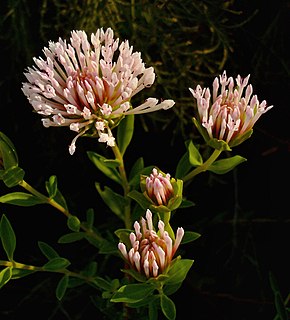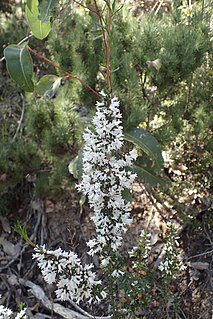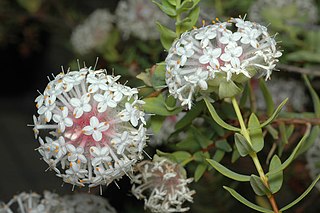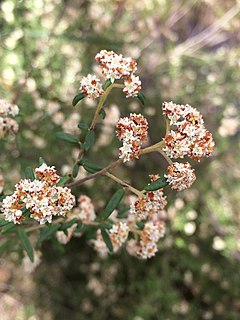
Pimelea calcicola is a species of flowering plant in the family Thymelaeaceae and is endemic to part of the west coast of Western Australia. It is an erect to spreading shrub with elliptic leaves arranged in opposite pairs, and head-like racemes of pale to deep pink, tube-shaped flowers surrounded by leaf-like involucral bracts.

Cryptandra arbutiflora, commonly known as waxy cryptandra, is a species of flowering plant in the family Rhamnaceae and is endemic to the southwest of Western Australia. It is a shrub with spiny branches, elliptic to linear leaves and tube-shaped white flowers.
Baeckea uncinella is a species of flowering plant in the family Myrtaceae and is endemic to the south coast of Western Australia. It is a shrub with narrowly egg-shaped to linear leaves and small white flowers with seven to thirteen stamens.

Lasiopetalum glabratum is a species of flowering plant in the family Malvaceae and is endemic to the south-west of Western Australia. It is an erect shrub with densely hairy young stems, egg-shaped leaves and pale mauve-pink reddish-purple flowers.

Pomaderris myrtilloides is a species of flowering plant in the family Rhamnaceae and is endemic to near-coastal areas of southern Western Australia. It is an erect shrub with many branches, narrowly egg-shaped elliptic or wedge-shaped leaves with the narrower end towards the base, and cream-coloured to pale pink flowers.

Lasiopetalum trichanthera is a species of flowering plant in the family Malvaceae and is endemic to a restricted area in the south-west of Western Australia. It is an erect to straggling, sticky shrub with many hairy stems, egg-shaped leaves and bright pink and dark red flowers.

Pimelea avonensis is a species of flowering plant in the family Thymelaeaceae and is endemic to the south-west of Western Australia. It is a shrub with narrowly egg-shaped or elliptic leaves and clusters of white, tube-shaped flowers.
Spyridium glaucum is a species of flowering plant in the family Rhamnaceae and is endemic to a restricted area of south-western Western Australia. It is an erect or spreading shrub with egg-shaped leaves, and clusters of 3 to 6 rusty-hairy flowers.

Cryptandra aridicola is a flowering plant in the family Rhamnaceae and is endemic to inland areas of Western Australia. It is a small, spreading shrub with white or pink flowers.
Spyridium minutum is a species of flowering plant in the family Rhamnaceae and is endemic to the south of Western Australia. It is an erect or spreading shrub with broadly egg-shaped or heart-shaped leaves, and groups of two or three hairy, white flowers.
Spyridium montanum is a species of flowering plant in the family Rhamnaceae and is endemic to the Stirling Range in the south of Western Australia. It is an erect shrub with elliptic or egg-shaped leaves, and groups of up to ten densely hairy, white or cream-coloured flowers.
Spyridium mucronatum is a species of flowering plant in the family Rhamnaceae and is endemic to the south of Western Australia. It is an erect or spreading shrub usually with narrowly oblong leaves, and dense clusters of up to ten densely hairy, white to yellow flowers.
Cryptandra apetala is a species of flowering plant in the family Rhamnaceae and is endemic to the south-west of Western Australia. It is a shrub with tufted, linear to lance-shaped leaves, and urn-shaped white to creamy-white and pink flowers arranged on short side shoots.

Pimelea cracens is a species of flowering plant in the family Thymelaeaceae and is endemic to the southwest of Western Australia. It is an erect, spindly shrub with narrowly elliptic to egg-shaped leaves and creamy green to pale yellow flowers surrounded by 6 or 8 yellowish or pale green and reddish involucral bracts.

Spyridium oligocephalum is a species of flowering plant in the family Rhamnaceae and is endemic to the south-west of Western Australia. It is a shrub that typically grows to a height of 0.6–1.5 m, its leaves glabrous except when very young. There are large, papery, orange-brown stipules joined in pairs at their bases, at the base of the petiole. The flowers are arranged in head-like, condensed cymes on the ends of branchlets. The sepals are about 1 mm (0.039 in) long and densely covered with hairs 0.3–0.5 mm (0.012–0.020 in) long.
Cryptandra beverleyensis is a species of flowering plant in the family Rhamnaceae and is endemic to the southwest of Western Australia. It is a shrub with narrowly oblong leaves and clusters of white, tube-shaped flowers.
Pimelea drummondii is a species of flowering plant in the family Thymelaeaceae and is endemic to near-coastal areas of southern Western Australia. It is an erect, slender shrub with narrowly elliptic or elliptic leaves arranged in opposite pairs, and white or cream-coloured flowers surrounded by 3 or 4 pairs of pale green to yellowish involucral bracts.

Cryptandra connata is a species of flowering plant in the family Rhamnaceae and is endemic to inland Western Australia. It is an erect, prickly shrub with linear to lance-shaped leaves and clusters of white, pink or purple, tube-shaped flowers.

Spyridium riparium is a species of flowering plant in the family Rhamnaceae and is endemic to the south of Western Australia. It is an erect shrub, usually with narrowly egg-shaped leaves, and clusters of densely hairy, white or cream-coloured flowers.
Cryptandra craigiae is a flowering plant in the family Rhamnaceae and is endemic to a restricted area of southern Western Australia. It is a shrub with linear leaves and dense clusters of white or cream-coloured, tube-shaped flowers.











